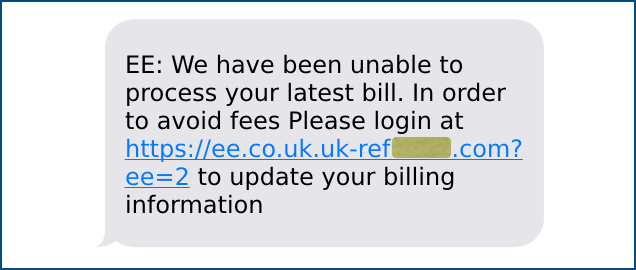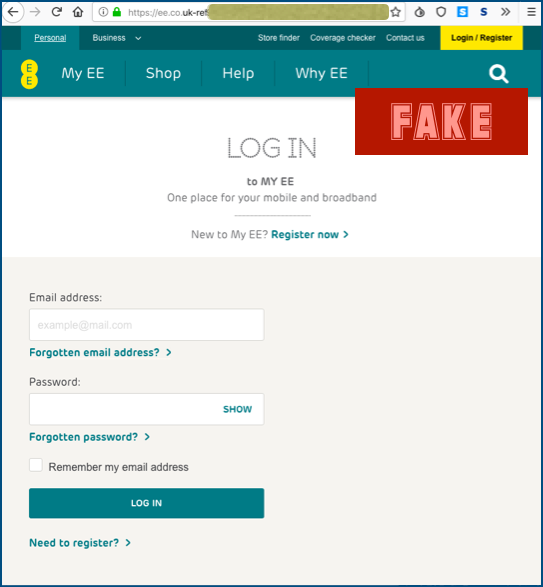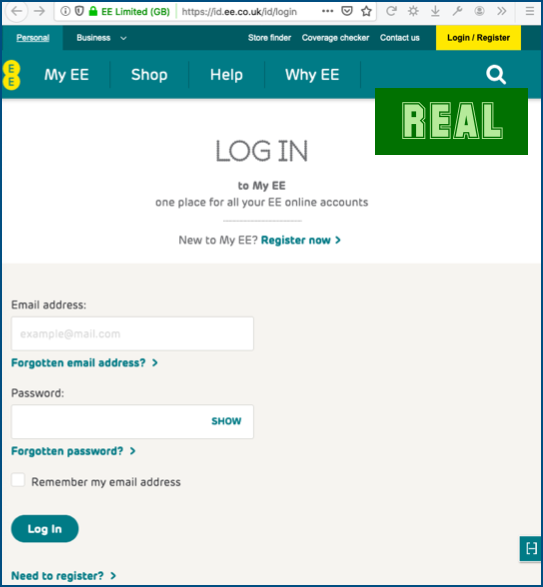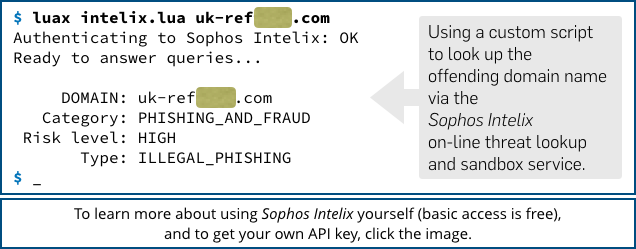Phishy text message tries to steal your cellphone account
Lots of people still think of phishing as a type of scam that arrives by email.
That’s because most phishing attacks do, indeed, arrive in your inbox – sadly, spamming out emails is cheap and easy for crooks, and it delivers results simply because of the volume they can achieve.
But phishing isn’t only about email – it’s a scamming technique that applies to every form of electronic messaging, including social media, instant messaging…
…and even, or perhaps especially, good old SMS texts.
One of the delightful simplicities of SMS is that it was designed back when mobile phones first came out, and thus when network bandwidth was limited.
So SMSes are short, simple, and text-only, and this stripped-down nature actually makes them ideal for crooks.
Messages sent via SMS unexceptionably use a brief and direct style that makes it much easier to get the spelling and grammar right.
The brevity of SMSes also means that shortened or unusual-looking URLs are commonplace, so we’re more inclined to accept them than we would be if they showed up in an email.
Even though services such as Skype, WhatsApp, Instagram and Snapchat have become the first-choice messaging apps of today’s youngsters, SMS has never gone away, because every phone, on every network, in every country, still supports it.
In the UK, for example, most pay-as-you-go mobile plans throw in ‘unlimited SMSes’ as an incentive to attract users to their plans – you might not need SMS any more, but it’s certainly handy to have an all-you-can-eat SMS buffet thrown in with every basic deal.
And which sort of company is most likely to contact you via SMS?
Why, your mobile phone provider, of course!
They know the message will get through, because they manage your account, and they know your phone handset will definitely be able to display it.
Like this:

OK, so you ought to spot this as a scam, because the crooks have messed up the English slightly (we’re not going to give them a free grammar lesson here, but a few tweaks would improve the looks greatly), and because they have, of necessity, created a bogus domain that’s visibly different from the genuine one.
The crooks can’t use the domain name ee DOT co DOT uk, of course, because that’s the real deal and would take you to mobile provider EE’s genuine website.
But the crooks can put ee DOT co DOT uk at the left-hand end of an innocent-looking domain name of their own for a touch of realism.
And in this case, they’ve registered the name uk-ref[redacted] DOT com, which doesn’t look entirely out of place, given that EE is a UK company, and this scam is aimed at users in the UK.
For a German provider, the crooks could just put de- at the start of their domain name, or use ca- for Canada, and so on.
In this case, the crooks haven’t done any targeting of their attack – the member of our team who received this phish wasn’t actually on EE’s network, so they were in no doubt that it was fraudulent.
But EE is one of the UK’s biggest mobile providers, so a significant minority of recipients will see a message that does match their network.
In theory, the first few digits of each number would have given the crooks a good guess at each network provider, so targeting this SMS scam to each recipient’s home network would have been fairly easy. That would have avoided ‘false positives’ where the recipients realised at once that they were being scammed. On the other hand, number-to-network directories aren’t always 100% correct, and some users have multiple SIMs, so the crooks may have decided instead to avoid ‘false negatives’, where they might miss out on potential victims by needlessly leaving them off the list. When the cost of sending 100,000 messages is not significantly higher than sending 10,000 or even 1000, there is little reason for the crooks to hold back.
As you can see, the crooks seem to be paying heed to the old adage that you catch more flies with honey than with vinegar.
Although this scam is trying to trick you into logging on in order to avoid something bad, the crooks aren’t squeezing you too hard.
The crooks are fraudlently claiming that they’re trying to bill you, which is something that you expect to happen every month if you’re on a contract, but they’re not threatening to cut you off if you DON’T PAY RIGHT NOW, and they haven’t littered their message with SPELING MISTEAKS, outrageous DEMANDS and too many EXCLAMATION POINTS!!!
The crooks even said “please”, and are offering you a reasonable-sounding chance to correct the mistake before you rack up late payment fees.
Of course, if you click through you will need to log on, as you might expect if you want to check your user profile and your billing data, and the crooks present an almost-perfect ripoff of the real thing:

For reference, EE’s real login page looks like this [2019-10-16T10:00Z]:

The site shown above was hosted via a cloud-based web service that handily provides its customers with a basic web server that’s already configured with an HTTPS certificate, so your browser shows you a padlock, thus avoiding an alert of an unencrypted site.
Happily, this password-stealing site was quickly and widely blocked by cybersecurity companies and browsers, and has now been taken down, but anyone who inadvertently put in their password would immediately have passed it to the crooks.
What to do?
- Change your password as soon as you can. If you think you just gave away your password by mistake, go and change it on the real site right away. Don’t wait to see what happens – get there before the crooks do. Don’t risk getting locked out of your own account, trying to convince your service provider that you aren’t the crook!
- Look for obvious mistakes in messages. The crooks have upped their game and make fewer mistakes than they used to, but they still need to use bogus domain names, and they often make some mistakes. If any evidence of phishiness is there, make sure you act on it.
- Don’t login via links sent from outside. Bookmark each provider’s logon page for yourself, or use a password manager that ties passwords to specific URLs. That way you won’t get suckered into visiting a fake login page that a crook pre-selected for you.
- Report phishing scams – please do your bit to help everyone else. You can report potential cyberthreats – files, emails and URLs – to Sophos via our Submit a Sample page. In the UK, report phishes to law enforcement via Action Fraud. In the USA, use the FBI’s Internet Crime Complaint Center.
By the way, given that it’s Cybersecurity Awareness month, we’ve been publishing a light-hearted poem each day on @NakedSecurity – and below you’ll find some gentle advice about not letting your guard down when the crooks are out to get you.
Whatever you do, don’t be this guy…
I can spot a phish for miles
You’ll never catch me out.
I know when you’re deceiving me –
There’s never… twitter.com/i/web/status/1…
—
Naked Security (@NakedSecurity) October 10, 2019
Article source: http://feedproxy.google.com/~r/nakedsecurity/~3/i_zR2R90vUk/
